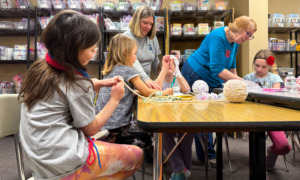Thanks to an ambitious initiative passed by its voters, California is the nation’s largest incubator of after-school programming. But the state’s effort to implement a statewide after-school effort quickly provides important lessons about the risks of rapid growth in a field that in California confronts shortages in both work force and participants.
Although state voters in 2002 approved the theory of a massive increase in the statewide after-school program, funding was not immediately available. The trigger for the money was an assortment of state revenue benchmarks that were met in fiscal 2007. The implementing legislation passed in September 2006, the application deadline was that November, and by February of last year the full $550 million in appropriations had gushed into the system as the After School Education and Safety (ASES) initiative. (See “How to … Bring After School to Scale,” Youth Today, October.)
There were challenges inherent in ASES. Strictures in the legislative process meant the California Board of Education could do little to prepare for the tumultuous startup; other requirements by the board meant that new programs had to be up and running within 60 days of receiving their grants. More than 16,000 new workers had to be hired, some in school districts that had never before run after-school programs. And participants had to be found for the programs, some in areas where after-school programs had never existed.
The number of programs in elementary and middle schools grew from 2,000 to 4,000, while the number in high schools more than quadrupled, from 44 to 190.
The process took state administrators and local districts on a wild ride, straining “the state’s after- school infrastructure at all levels, from administration by the California Department of Education to program staffing at local schools,” according to a review by Children Now, a California nonprofit collaborating on after-school improvement efforts statewide.
Wanted: Workers
The report, “Effectively Expanding California’s After School System: Overcoming the Workforce Supply Obstacle,” notes that although administrators sensed a pent-up demand for the new jobs – most of them part-time, paying $10 to $15 an hour – it was difficult to tap the pools of interested workers using the mostly in-house systems that were first employed. And while the minimum educational requirements for the jobs were few, they were often misread, eliminating some prospects. The most successful districts were those that used innovative recruiting techniques, including posting openings on http://Craigslist.com and other job-listing sites and exploring the talent pools of other community providers, such as Boys & Girls Clubs and community colleges.
Major staff turnover continues, even as experts say that quality staffers are the key to attracting youth.
After-school programs need to be “enriching, wonderful places to be,” said Samantha Tran, associate director of education at Children Now, and “what’s core to make that happen is staff.”
Work force development for ASES is an issue, according to Sandra McBrayer, chairwoman of the state’s 13-member advisory board for before- and after-school programs. But McBrayer emphasized what she said was a bigger issue: increasing the number of children who attend available after-school programs.
According to Children Now data, the percentage of students served by after-school programs in some counties in California is low, in the range of 10 percent to 14 percent.
“It’s like the chicken and the egg,” said McBrayer, who is also CEO of the Children’s Initiative, a child advocacy organization in San Diego. “If I don’t have quality staff, I can’t keep my kids, but if I’m not getting my kids to the door, I’m going to be laying staff off.”
She said many after-school outlets never really focused on outreach; they were too busy getting their programs up and running. “We must market our availability to parents and to teachers,” she said. A portion of ASES grants can be set aside for marketing efforts, which McBrayer said can be extremely low cost. Among them: Students serving as after-school ambassadors, for instance, can be rewarded with movie passes or T-shirts; or fliers can be sent home to parents.
As ASES matures, she said, programs are doing a better job of reaching out to parents who might be unaware that free after-school programs are available in their communities.
Teachers, too, need to regard the programs as essential educational tools: After all, McBrayer noted, California law mandates that after-school programs provide at least 45 minutes of homework assistance. Even law enforcement can be engaged to refer idle students to after school.
Because the Department of Education is talking about the issue “all the time,” it remains front and center, she added.
Despite what he termed “growing pains,” Steve Fowler, a state public education communications consultant with FowlerHoffman, said “Californians have built something quite significant.” He called ASES largely “a big success.”
Training New Workers
A coalition of after-school partners is piloting a number of worker recruitment and retention initiatives. They include:
• Identifying new worker pipelines, along with existing and new funding streams to support workers – a project of the California Network Workforce Innovation (CalWIN).
• Informing various groups, including elementary, middle school and high school authorities, work force investment boards, the after-school community and eventually state policymakers about successful strategies for recruiting and retaining workers – a project of Children Now.
• Linking youth workers who are disconnected from career paths to positions with higher demands and higher wages – an undertaking of the California School Age Consortium (CalSAC). This is part of a larger, multi-county initiative called the Gateway Project, funded by the Walter S. Johnson Foundation.
Scratching the Surface
But work force development efforts in California are just scratching the surface, said Rebecca Goldberg, CalSAC’s regional strategies director. For example, she said that out of about 10,000 after-school positions in the Los Angeles area, one-third of the slots are vacant at any given time. CalSAC is involved in a number of worker recruitment efforts, such as linking after school with teacher training programs and urging that young tutors be trained in after-school instruction. Other models “are proliferating,” she said, including those that integrate community colleges and after-school training.
One of the initiatives, the Career Ladders Project for California Community Colleges, is funneling $1.5 million to five community college districts to link after-school employment to career pathways.
“I think we’re getting there, but ultimately we’re going to have to do more scaling of these pilot projects and figure out ways to utilize some public funding streams to do so,” Goldberg said.
Other organizations involved in similar efforts include Better Educated Students for Tomorrow in Los Angeles (LA’s BEST) and the Central Valley Afterschool Foundation in Clovis, Calif.
Efforts to improve student recruitment in after-school include establishing youth councils to involve kids in program development and improving outreach to parents, parent-teacher organizations, educators and community-based organizations through marketing and education, McBrayer said.































